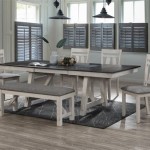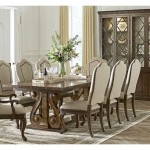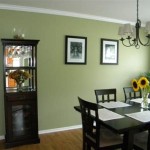Farmhouse Dining Room Table With Leaves: Expanding Style and Functionality
The farmhouse dining room table with leaves represents a significant investment in both the aesthetic and functional aspects of a home. Characterized by its rustic charm and inherent adaptability, this type of table serves as a focal point for family gatherings and entertaining. The inclusion of leaves—removable sections that extend the table's surface area—enhances its versatility, accommodating both intimate dinners and larger celebrations. The selection of a farmhouse dining room table with leaves necessitates careful consideration of several factors, including material, size, style, and mechanism for extending the table.
Farmhouse style, in general, embraces a relaxed and comfortable atmosphere, often incorporating natural materials and a sense of history. A farmhouse dining room table embodies these qualities through its robust construction, often utilizing solid wood such as pine, oak, or reclaimed lumber. The table tops may feature distressed finishes, showcasing the natural grain and imperfections of the wood, which contribute to its rustic appeal. The legs are typically sturdy and substantial, often featuring turned or trestle designs that add to the table's visual weight and stability. The addition of leaves maintains the table's aesthetic integrity while significantly increasing its functionality.
Key Considerations for Selecting a Farmhouse Dining Room Table With Leaves
Choosing the right farmhouse dining room table with leaves involves evaluating several crucial elements to ensure it meets both aesthetic preferences and practical needs. These key considerations will guide the selection process, resulting in a purchase that enhances the dining space and provides years of reliable service.
1. Material and Durability: The selection of the material is vital for the table's longevity and overall aesthetic. Solid wood, particularly hardwoods like oak, maple, and walnut, are renowned for their durability and resistance to wear and tear. These woods can withstand daily use and maintain their structural integrity for generations. Pine, while softer than hardwoods, offers a more budget-friendly option and can still provide a charming farmhouse aesthetic, especially when finished with a durable sealant. Reclaimed wood adds a unique character and sustainability aspect, but it is essential to ensure the wood is properly treated and stabilized to prevent warping or cracking.
The finish applied to the wood is another critical factor in durability. Protective finishes such as polyurethane or varnish create a barrier against moisture, scratches, and stains. Matte finishes tend to highlight the natural grain and texture of the wood, while glossy finishes offer a more polished and refined look. The chosen finish should align with the desired aesthetic and the expected level of use. For high-traffic dining rooms, a more durable and easily cleanable finish is recommended.
2. Table Size and Leaf Mechanism: The dimensions of the dining room and the typical number of diners will dictate the appropriate size of the table. It is essential to measure the available space and consider the clearance needed around the table for comfortable seating and movement. A general guideline is to allow at least 36 inches of space between the table and any walls or furniture.
The number and size of the leaves will determine the table's maximum seating capacity. Consider the frequency of large gatherings and the number of guests typically hosted. Some tables feature a single leaf, while others may have two or more, allowing for incremental increases in size. The leaf mechanism should be smooth and easy to operate, enabling quick and effortless adjustments to the table's length. Common types of leaf mechanisms include butterfly leaves, drop-in leaves, and geared slides. Butterfly leaves are hinged and fold out from underneath the table top, while drop-in leaves are separate pieces that insert into the center of the table. Geared slides allow for smooth and synchronized extension of the table halves, creating a seamless surface when the leaves are inserted.
3. Style and Design Compatibility: A farmhouse dining room table should complement the existing décor and overall style of the home. Farmhouse style encompasses a range of sub-styles, including traditional farmhouse, modern farmhouse, and rustic farmhouse. Traditional farmhouse tables often feature classic designs with turned legs and a simple, unadorned aesthetic. Modern farmhouse tables incorporate cleaner lines and a more streamlined silhouette, blending rustic elements with contemporary design principles. Rustic farmhouse tables emphasize the natural imperfections and raw beauty of the wood, often showcasing distressed finishes and visible knots and grains.
The color and finish of the table should also coordinate with the surrounding furniture and walls. Neutral colors such as white, gray, and natural wood tones are common choices for farmhouse dining tables, as they provide a versatile backdrop for various décor styles. Accents such as metal hardware or contrasting wood tones can add visual interest and enhance the table's character. It is crucial to consider the overall color palette of the dining room and select a table that complements the existing elements. The chairs chosen to accompany the table should also align with the farmhouse aesthetic, featuring materials such as wood, wicker, or upholstered fabrics in neutral colors or subtle patterns.
4. Storage of Leaves: Another practical consideration is where to store the leaves when they are not in use. Some tables come with built-in storage compartments for the leaves, which can be incredibly convenient and space-saving. If the table does not have built-in storage, it will be necessary to designate a separate storage area, such as a closet or cabinet, to keep the leaves protected and readily accessible. Proper storage will prevent damage to the leaves and ensure they are in good condition when needed. Covering the leaves with a protective cloth or storing them in a padded case can further minimize the risk of scratches or dents.
5. Budget and Value: The price of a farmhouse dining room table with leaves can vary widely depending on the material, size, design, and brand. It is essential to establish a budget before beginning the search and to prioritize the features that are most important. While it may be tempting to opt for the least expensive option, it is crucial to consider the long-term value and durability of the table. Investing in a higher-quality table made from solid wood with a durable finish will likely result in a more satisfying and long-lasting purchase. Comparing prices from different retailers and considering sales or discounts can help to find the best value for the money. Reading reviews and seeking recommendations from other owners can also provide valuable insights into the quality and performance of the table.
Types of Leaf Mechanisms in Farmhouse Dining Tables
Understanding the different types of leaf mechanisms available in farmhouse dining tables is crucial for selecting a table that meets functional requirements. Each mechanism offers unique advantages and may be better suited to specific design preferences or usage patterns.
1. Butterfly Leaf: The butterfly leaf mechanism is characterized by its self-storing design. The leaf is hinged and folds out from beneath the table top, eliminating the need for separate storage. This mechanism is particularly convenient for smaller spaces where storage is limited. The butterfly leaf is typically located in the center of the table and can be easily deployed by pulling apart the table halves. The hinges allow the leaf to swing into place, creating a seamless extension of the table surface. While butterfly leaves are convenient, they may not be suitable for extending the table by a significant amount, as the size of the leaf is limited by the space available beneath the table top. Also, the folding nature can, over time if not cared for, loosen hinges, potentially affecting the alignment of the table surface.
2. Drop-In Leaf: Drop-in leaves are individual sections that are inserted into the center of the table to extend its length. This type of mechanism requires separate storage for the leaves when they are not in use. Drop-in leaves offer greater flexibility in terms of table size, as multiple leaves can be added to accommodate a larger number of diners. The leaves are typically held in place by metal brackets or wooden supports that ensure a secure and stable connection. The insertion and removal of drop-in leaves can be slightly more cumbersome than other mechanisms, as it requires lifting and aligning the leaves with the table top. However, drop-in leaves offer a clean and seamless appearance when properly installed, creating a smooth and uniform surface.
3. Geared Slides: Geared slides utilize a synchronized mechanism to smoothly extend the table halves, creating space for the insertion of leaves. This type of mechanism is often found in higher-end dining tables and offers a superior level of precision and ease of use. The geared slides ensure that the table halves move apart evenly, maintaining perfect alignment throughout the extension process. The leaves are typically stored separately and can be easily inserted into the gap created by the extended table halves. Geared slides are particularly well-suited for large dining tables that require significant extension, as they provide a stable and secure platform for accommodating a large number of diners. The geared mechanism often adds to the cost of the table. As with any mechanical system, they might require occasional maintenance to keep the movement smooth.
Care and Maintenance of a Farmhouse Dining Table With Leaves
Proper care and maintenance are essential for preserving the beauty and longevity of a farmhouse dining room table with leaves. Regular cleaning, protective measures, and occasional repairs will help to keep the table looking its best and functioning properly for years to come.
1. Regular Cleaning: The frequency and type of cleaning will depend on the finish and material of the table. For most solid wood tables with a protective finish, regular dusting with a soft cloth is sufficient to remove everyday dirt and debris. Spills should be cleaned up immediately with a damp cloth to prevent staining. Avoid using harsh chemicals or abrasive cleaners, as these can damage the finish. For more stubborn stains, a mild soap and water solution can be used, followed by a thorough drying. Wood tables should occasionally be polished with a high-quality wood polish to maintain their luster and protect the finish. The leaves should also be cleaned and polished regularly to ensure they maintain a uniform appearance with the rest of the table.
2. Protective Measures: Using placemats, coasters, and table runners can help to protect the table surface from scratches, stains, and heat damage. Hot dishes should always be placed on trivets or heat-resistant pads to prevent scorching the finish. Sharp objects, such as knives and forks, should be used with care to avoid scratching the surface. For tables that are frequently used for crafts or other activities, a protective tablecloth or mat can provide an extra layer of protection. The leaves should be stored in a safe and protected location to prevent damage when they are not in use. Covering the leaves with a protective cloth or storing them in a padded case can minimize the risk of scratches or dents.
3. Addressing Damages: Scratches, dents, and other minor damages can occur over time with regular use. Small scratches can often be repaired with a touch-up marker or wax crayon that matches the color of the finish. Deeper scratches may require sanding and refinishing the affected area. Dents can sometimes be removed by applying a damp cloth and heat from an iron, which can help to swell the wood fibers back to their original shape. If the damage is extensive, it may be necessary to consult with a professional furniture repair specialist. Regular inspections of the table's structure, including the legs, frame, and leaf mechanisms, can help to identify and address any potential problems before they escalate. Tightening loose screws, lubricating moving parts, and making minor repairs as needed will ensure that the table remains stable and functional for years to come. Proper care and maintenance, as outlined above, preserves the investment and ensures that the farmhouse dining room table remains an attractive and functional centerpiece within the home.

Massive Large Farmhouse Table Long 10 Foot 11 12 13 14 All Sizes Stains Etsy

Large Butterfly Leaf Farm Table 44 X 72 Opens To 96 Rustic Natural Grey Linen 1 490 Restored Timbers

Diy Farmhouse Table With Extension Leaves Plans Sweet Tooth Life

7 Piece Dining Table Set Extendable With 12 Leaf And 2 Drawers 6 Chairs Soft Cushion Brown White

Homestead Dining Table With Butterfly Leaf Rustic Ranch Furniture And Decor

Rhomtree 7 Piece Farmhouse Dining Set With Multifunctional Extendable Table Chair Rustic Brown Gray

Harper Bright Designs Farmhouse 6 Piece Natural Wood Top Extendable Table Set Seats With 1 Bench 4 Chairs And 18 In Removable Leaf Dt186aaa

Farmhouse 7 Piece Dining Set Multifunctional Extendable Table With 12 Leaf And 2 Drawers Cushioned Chairs For 6 Persons Room

Farmhouse Round Extendable Dining Table With 16 Leaf Wood Kitchen Espresso

Americana Modern Dining 88 112 2 Piece Trestle Table With 24 Butterf Parker House Furniture








